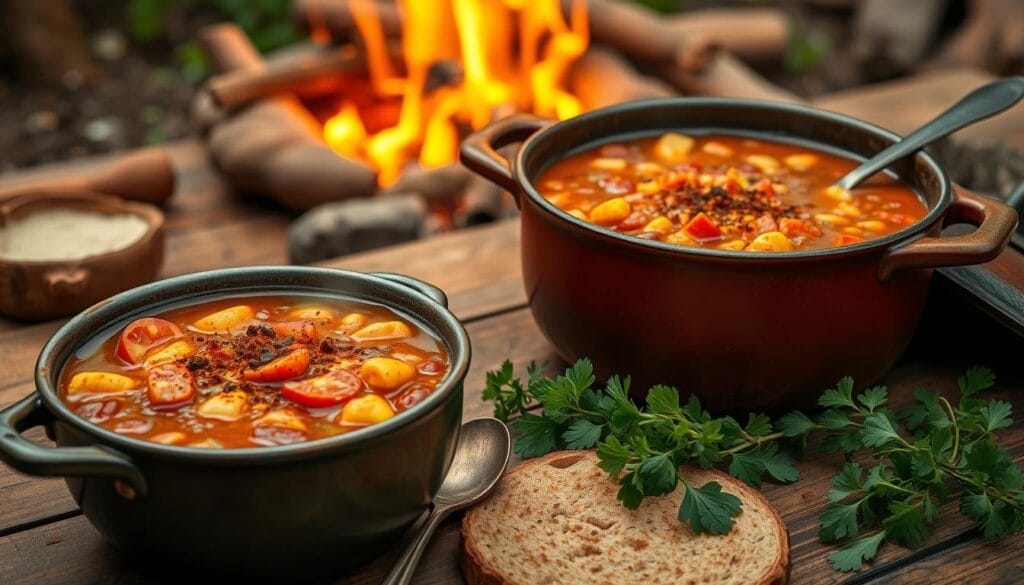When the sun goes down, the air gets crisp, and we all want something warm. A bowl of Cowboy Soup is perfect for this. It’s full of savory meats, tender veggies, and rich flavors.
This dish takes you back to the Old West. It’s a time when life moves slower and we appreciate the little things more.
Cowboy Soup is great for big families or meal prep. It makes 12 servings, perfect for any gathering. The mix of ground beef and Italian sausage gives it a tasty flavor. Plus, making it thick is easy, so you can enjoy it just right.
Main Highlights :
- Cowboy Soup is a hearty, flavorful dish that can feed a crowd or serve as a convenient meal prep option.
- The soup features a blend of ground beef and Italian sausage, creating a well-balanced meaty flavor.
- Thickening the soup is an easy process, allowing you to achieve the perfect consistency for your taste preferences.
- The recipe is versatile, with options to customize the ingredients and adjust the spice level to your liking.
- Cowboy Soup can be cooked in a variety of ways, including on the stovetop, in a slow cooker, or using an Instant Pot, providing flexibility in your cooking method.
Understanding Cowboy Soup Basics and Consistency
Cowboy soup is a hearty dish loved in many Western and rural areas. It’s thick and full of flavor, perfect for warming up after a long day. Knowing its traditional parts, ideal thickness and common issues helps us enjoy it more.
Traditional Cowboy Soup Components
A classic cowboy soup starts with ground beef or sausage. It’s then mixed with fresh and canned veggies like potatoes and corn. Ranch beans and Rotel tomatoes add depth. Spices like chili powder and cumin make it flavorful.
Ideal Soup Thickness Standards
The perfect cowboy soup is thick and hearty. Its rich broth holds onto the ingredients. This makes each part of the soup shine and blend well together.
Common Thickness Issues
Getting the soup’s thickness just right is tricky. Too watery and the flavors get lost. Too thick and it hides the ingredients. Using the right thickening methods is key to enjoying the soup’s true taste.
Essential Ingredients for a Perfect Cowboy Soup Base
Making a tasty cowboy soup base is key to a great meal. You need lean ground beef, Italian sausage, and onions. Carrots, celery, diced tomatoes, and Rotel tomatoes with green chilies are also important. Don’t forget ranch-style beans, sweet corn, green beans, and russet potatoes.
For that smoky cowboy soup flavor, use garlic powder, cumin, oregano, chili powder, and smoked paprika. These spices blend to make a warm and comforting broth.
Cowboy soup is flexible. You can use ground chicken or turkey instead of beef. Try chicken or vegetable broth instead of beef broth. Adding sweet potatoes or fresh veggies can make the soup healthier and tastier.
Preparing cowboy soup ahead is smart. It keeps well in the fridge for four days or in the freezer for three months. To keep potatoes good, thaw the soup in the fridge before heating it up.

Cowboy soup is a great dish for any meal. With the right ingredients, you can make a meal that everyone will love.
How to Thicken Cowboy Soup
Getting the right consistency for your Cowboy Soup is key. It makes the dish hearty and satisfying. There are several ways to thicken your soup to the perfect texture.
Using Flour-Based Roux
Making a flour-based roux is a classic way to thicken Cowboy Soup. Mix equal parts of flour and fat, like butter or oil, over medium heat. Cook until it smells nutty and turns golden.
Then, slowly whisk the roux into your hot soup. Let it simmer until it thickens to your liking.
Cornstarch Slurry Method
The cornstarch slurry method is quick and easy. Mix cornstarch with cold water, then add it to your simmering soup. Stir constantly until it reaches the right thickness.
Natural Thickening Techniques
For a natural thickening, use the starchy ingredients in your soup. Mash or puree some potatoes or beans in the soup. You can also blend in pureed veggies like carrots or bell peppers.
These methods let you adjust your Cowboy Soup’s consistency. You can make it hearty and delicious for everyone to enjoy.

The Role of Potatoes in Thickening
Potatoes are key in thickening Cowboy Soup. As they cook, they add natural thickening agents to the broth. This makes the soup thicker and better.
Russet potatoes work especially well because they have a lot of starch. This makes them great for thickening.
To make the soup even creamier, mash some cooked potatoes into it. This adds a velvety texture and helps all the ingredients stick together. It makes the soup more satisfying.
| Ingredient | Quantity |
|---|---|
| Russet Potatoes | 4 large |
| Whole Milk | 2 cups |
| Prep Time | 20 minutes |
| Cooking Time | 40 minutes |
| Serves | 6 people |
Using russet potatoes as a potato thickener and starch thickening agent makes your Cowboy Soup perfect. It becomes a hearty and comforting dish that everyone will love.
Bean-Based Thickening Methods
Beans are great for thickening Cowboy Soup and making it more filling. There are a few ways to use beans as bean thickeners.
Mashing Portion of Beans
Mashing some of the mashed beans in the soup works well. It releases starch, making the soup thicker and creamier.
Using Bean Puree
You can also make a bean puree by blending cooked beans. Then, mix it into the soup. This adds richness and body without changing the taste much.
Incorporating Additional Beans
To make the soup even thicker, add more beans. This makes the soup more filling and satisfying.
Using beans to thicken your soup is a great way to avoid flour or cornstarch. Try different bean methods to find your favorite way to make the soup just right.

Vegetable-Based Thickening Techniques
Vegetables can make your Cowboy Soup thicker. Puree some cooked veggies and mix them back in. This adds natural thickness and body. Carrots, celery, or cauliflower work well because they’re high in starch or fiber.
To thicken your soup with veggies, take a cup or two of cooked veggies. Blend them until smooth. Then, stir the pureed veggies back into the soup. Let it simmer for a few minutes to mix well.
For more thickness, mash some pureed veggies into the soup. Use a potato masher or the back of a spoon. This releases starches and fibers, making the soup thicker and heartier.
| Vegetable | Thickening Potential | Nutritional Benefits |
|---|---|---|
| Carrots | High in starch and fiber | Rich in vitamin A, antioxidants |
| Celery | Moderate in fiber | Provides essential vitamins and minerals |
| Cauliflower | High in fiber and starch | Packed with vitamins, minerals, and antioxidants |
Using veggies to thicken your Cowboy Soup makes it heartier and more satisfying. It’s not just tasty but also good for you. Try different veggies to see how they change your soup’s texture and taste.
Professional Tips for Achieving Perfect Consistency
Making the perfect Cowboy Soup is an art. Getting the right consistency is key. As a seasoned chef, I’ll share tips to help you get it just right.
Temperature Control
Keeping the right temperature is crucial. Simmer the soup gently to blend flavors and thicken naturally. Don’t let it boil too fast, as it can mess up the texture.
Timing Considerations
When to add thickeners is important. Too soon and it’s gummy, too late and it won’t mix well. Follow the recipe’s timing for the best result.
Stirring Techniques
Stirring often and gently is key. It spreads heat and stops ingredients from sticking. Use a spoon or whisk to mix without breaking the soup’s texture.
With these tips, you’ll make Cowboy Soup perfectly every time. Enjoy its rich flavors with confidence.
Common Mistakes to Avoid When Thickening
Thickening Cowboy Soup needs care to get it right. Adding too much thickener at once can make it gloopy or gummy. It’s better to add thickeners slowly for the best texture.
Don’t overcook the soup after adding thickeners. This can make the soup thin again. Keep the heat low and watch the soup closely to avoid this.
Using the wrong amount of thickener can mess up the soup’s texture. Always follow recipes or use measured amounts when trying new things.
Boiling the soup too fast after adding thickeners can make it separate. Keep the heat gentle and stir slowly to mix the thickeners well.
- Avoid adding too much thickener at once, which can lead to a gloopy or gummy texture.
- Prevent overcooking the soup after adding thickeners, as this can break down the starch molecules and thin the soup.
- Ensure accurate measurements of thickening agents to achieve consistent results.
- Steer clear of rapid boiling after adding thickeners, as this can cause the soup to separate.
By avoiding these mistakes and following good practices, you can make Cowboy Soup thick and hearty every time.
Alternative Thickening Agents and Substitutes
There are many ways to thicken your Cowboy Soup, not just flour or cornstarch. These options can change the texture, fit special diets, and add nutrients. Let’s look at some great alternatives for your Cowboy Soup.
Arrowroot powder is a top pick for those who can’t have gluten. It makes your soup clear and shiny. Instant potato flakes are quick and easy to use. They make your soup creamy.
If you’re gluten-free, try rice flour or coconut flour. They make your soup smooth and velvety without gluten.
Want to make your soup healthier? Add chia seeds or ground flaxseeds. They thicken your soup and add lots of good stuff.
For a richer soup, use cream cheese or heavy cream. They make your soup creamy and luxurious.
Try these alternative thickeners and gluten-free options to find what you like. They can make your Cowboy Soup even better.
Storage and Reheating Thick Cowboy Soup
Storing and reheating your leftover cowboy soup right is key. It keeps the taste and texture great. Follow these tips to enjoy your soup days later.
Proper Storage Methods
For fresh thick cowboy soup, put leftovers in airtight containers. Store them in the fridge for 3-4 days. Freeze it in safe containers for 2-3 months. Thaw it in the fridge before reheating.
Reheating Guidelines
Reheat cowboy soup gently over medium heat. This keeps it smooth and prevents it from drying out. If it’s too thick, add a bit of broth or water. Stir until it’s right.
These easy storage and reheating techniques make your cowboy soup taste like new. Enjoy your comforting soup fully!
Health Considerations and Dietary Modifications
Cowboy soup is tasty and comforting. But, it’s key to think about health and diet when eating it. A few tweaks can make your cowboy soup healthy and fit many diets.
Want less fat? Try using lean ground turkey or chicken instead of beef. This cuts down fat and adds lean protein. Adding more veggies like beans, corn, or greens boosts fiber and nutrients.
On a low-sodium diet? Use low-sodium broth and cut down on salt. For gluten-free, pick gluten-free thickeners and make sure all ingredients are gluten-free.
Vegetarians or vegans? Swap meat for tofu, tempeh, or lentils. Use veg broth instead of meat broth. This makes the soup good for plant-based diets and boosts health benefits.
With these easy changes, you can enjoy cowboy soup while meeting your dietary needs. A healthy, tasty soup is possible with the right ingredients and cooking methods.
Conclusion
Cowboy Soup is a versatile and comforting meal. It can be easily customized to suit your preferences. By mastering different thickening techniques, you can make a perfect cowboy soup.
Remember, the key to the perfect consistency is understanding the ingredients and cooking methods. Also, make sure to store and reheat it properly. With practice, you’ll make a cowboy soup that warms the soul and delights your taste buds.
Whether you like a hearty beef-based soup or a vegetarian version, cowboy soup is versatile. You can experiment and find your perfect blend of flavors and textures. So, unleash your inner cowboy or cowgirl and make a batch of this comforting dish.
FAQ
What are the traditional components of Cowboy Soup?
Cowboy Soup traditionally has ground beef, onions, carrots, and celery. It also includes tomatoes, beans, corn, and potatoes.
What is the ideal thickness for Cowboy Soup?
Cowboy Soup should be thick and hearty. The broth should cling to the ingredients well.
What are the essential ingredients for a perfect Cowboy Soup base?
For a great Cowboy Soup base, use lean ground beef and Italian sausage. Add onions, carrots, and celery. Don’t forget diced tomatoes, Rotel tomatoes, and ranch-style beans.
Include sweet corn, green beans, russet potatoes, and beef broth. Spices like garlic powder and cumin are key.
What are the methods for thickening Cowboy Soup?
To thicken Cowboy Soup, you can make a flour-based roux. Or, use a cornstarch slurry. You can also mash potatoes or puree vegetables.
How do potatoes help thicken Cowboy Soup?
Potatoes, especially russet ones, are great for thickening. They release starch into the broth as they cook. Mashing some potatoes in the soup makes it creamier.
How can beans be used to thicken Cowboy Soup?
Beans can thicken Cowboy Soup in several ways. Mashing some beans in the soup adds starch. Or, make a bean puree to add.
Adding more beans also makes the soup thicker and more filling.
How can vegetables be used as natural thickeners for Cowboy Soup?
Vegetables can thicken Cowboy Soup naturally. Puree cooked veggies and stir them back in. Carrots, celery, or cauliflower work well.
What professional tips can help achieve the perfect Cowboy Soup consistency?
For perfect Cowboy Soup, control the temperature well. Add thickeners at the right time. Stir evenly to prevent sticking.
What common mistakes should be avoided when thickening Cowboy Soup?
Avoid adding too much thickener at once. Don’t overcook after adding thickeners. And, measure thickeners correctly to avoid uneven results.
What are some alternative thickening agents for Cowboy Soup?
Try arrowroot powder, instant potato flakes, or rice flour. Coconut flour, chia seeds, and ground flaxseeds also work. Cream cheese and heavy cream can thicken too.
How should thick Cowboy Soup be stored and reheated?
Store thick Cowboy Soup in airtight containers in the fridge for 3-4 days. Freeze for 2-3 months. Thaw frozen soup in the fridge overnight. Reheat on the stovetop, adding broth if needed.
How can Cowboy Soup be modified to suit different dietary needs?
For a lower-fat option, use lean ground turkey or chicken. Add more veggies for fiber and nutrients. Use low-sodium broth and reduce salt for low-sodium diets.
Substitute meat with plant-based proteins and use vegetable broth for vegetarian or vegan options.

